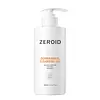What's inside
What's inside
 Key Ingredients
Key Ingredients

No key ingredients
 Benefits
Benefits

 Ingredients Side-by-side
Ingredients Side-by-side

Water
Skin ConditioningGlycerin
HumectantHydrogenated Palm Acid
Potassium Hydroxide
BufferingSodium Hyaluronate
HumectantHyaluronic Acid
HumectantHordeum Distichon Extract
Skin ProtectingTriticum Vulgare Sprout Extract
Skin ConditioningPhaseolus Radiatus Sprout Extract
HumectantBrassica Oleracea Italica Sprout Extract
EmollientGlyceryl Stearate
EmollientAcrylates/C10-30 Alkyl Acrylate Crosspolymer
Emulsion StabilisingSodium Phytate
Butylene Glycol
HumectantPolyquaternium-7
Pentylene Glycol
Skin Conditioning1,2-Hexanediol
Skin ConditioningOctanediol
Capryloyl Salicylic Acid
ExfoliatingNiacinamide
SmoothingEthylhexylglycerin
Skin ConditioningAscorbic Acid
AntioxidantSodium Benzoate
MaskingRosmarinus Officinalis Leaf Oil
MaskingWater, Glycerin, Hydrogenated Palm Acid, Potassium Hydroxide, Sodium Hyaluronate, Hyaluronic Acid, Hordeum Distichon Extract, Triticum Vulgare Sprout Extract, Phaseolus Radiatus Sprout Extract, Brassica Oleracea Italica Sprout Extract, Glyceryl Stearate, Acrylates/C10-30 Alkyl Acrylate Crosspolymer, Sodium Phytate, Butylene Glycol, Polyquaternium-7, Pentylene Glycol, 1,2-Hexanediol, Octanediol, Capryloyl Salicylic Acid, Niacinamide, Ethylhexylglycerin, Ascorbic Acid, Sodium Benzoate, Rosmarinus Officinalis Leaf Oil
Ingredients Explained
These ingredients are found in both products.
Ingredients higher up in an ingredient list are typically present in a larger amount.
1,2-Hexanediol is a synthetic liquid and another multi-functional powerhouse.
It is a:
- Humectant, drawing moisture into the skin
- Emollient, helping to soften skin
- Solvent, dispersing and stabilizing formulas
- Preservative booster, enhancing the antimicrobial activity of other preservatives
Glycerin is already naturally found in your skin. It helps moisturize and protect your skin.
A study from 2016 found glycerin to be more effective as a humectant than AHAs and hyaluronic acid.
As a humectant, it helps the skin stay hydrated by pulling moisture to your skin. The low molecular weight of glycerin allows it to pull moisture into the deeper layers of your skin.
Hydrated skin improves your skin barrier; Your skin barrier helps protect against irritants and bacteria.
Glycerin has also been found to have antimicrobial and antiviral properties. Due to these properties, glycerin is often used in wound and burn treatments.
In cosmetics, glycerin is usually derived from plants such as soybean or palm. However, it can also be sourced from animals, such as tallow or animal fat.
This ingredient is organic, colorless, odorless, and non-toxic.
Glycerin is the name for this ingredient in American English. British English uses Glycerol/Glycerine.
Learn more about GlycerinWater. It's the most common cosmetic ingredient of all. You'll usually see it at the top of ingredient lists, meaning that it makes up the largest part of the product.
So why is it so popular? Water most often acts as a solvent - this means that it helps dissolve other ingredients into the formulation.
You'll also recognize water as that liquid we all need to stay alive. If you see this, drink a glass of water. Stay hydrated!
Learn more about Water